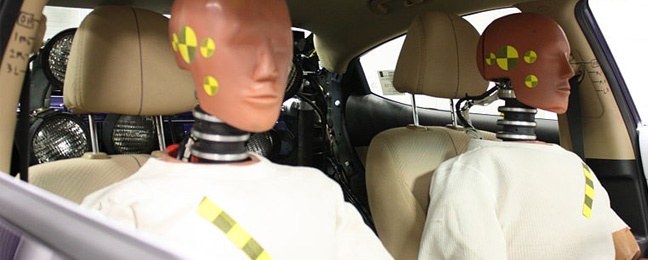

May 30 2012
NHSTA to Deploy Fleet of 2800 V2V-Ready Vehicles This Summer.
Most new vehicle technologies, including even safety features, are introduced as premium options on luxury vehicles. In the case of safety features these gradually become available to lower priced vehicle segments as it becomes more mainstream. However, the exception to this rule happens when regulations are put in place that require new technology be installed on new vehicles from a certain date forward. Based on the NHTSA’s interest in Vehicle-to-Vehicle (V2V) technology and possible safety benefits it may become one of those exceptions before too long.
Earlier this year the National Highway Traffic Safety Administration (NHTSA) conducted research and preliminary testing of V2V technology. This technology takes vehicle data and broadcasts it to other cars in the vicinity in an attempt to avoid accidents. Clearly, their initial efforts were promising as NHTSA administrator David Strickland revealed an Ann Arbor-based program testing some 2800 vehicles to be deployed this summer with V2V technology. The announcement was made by Strickland while speaking before the Society of Automotive Engineers (SAE) Conference in Detroit this April.
Initial NHSTA research suggests V2V technology could result in an 80% reduction in crashes involving non-impaired drivers of light-duty vehicles. Several kinds of collisions can be avoided when vehicles “talk” to each other. Each V2V-ready vehicle sends out a signal similar to internet WiFi that can be picked up by any V2V equipped vehicle located nearby. These signals provide data to the other V2V-ready vehicles around it relative to distance and speed. Once certain parameters are breeched, the system will trigger an alert to warn the driver of unseen highway dangers. According to DOT guidelines, the optimum V2V warnings would be:
The agency will assess the data over the next year and make a decision on it in 2013. In addition to testing V2V, they are also considering Vehicle-to-Infrastructure (V2I) technology that could facilitate additional vehicle data sharing for safety purposes. For example, such communications could be used to alert both drivers and pedestrians crossing the street of a vehicle approaching an intersection that appears likely to run a red light. The NHTSA predicts V2V technology will be present in 25% of all vehicles on the road by 2020.
It should be noted that the NHTSA is researching passive responses, like warnings and alerts, to the data collected by V2V systems. However, within the industry there are many who anticipate that the next step for this technology will be to utilize the data to initiate active vehicle responses to avoid accidents or to allow vehicles to drive themselves (Google is already exploring this).
While many are excited about the lifesaving aspects of this technology, there are also some privacy concerns about the driver and vehicle data collected and passed on in this kind of technology. Who would get it (Law enforcement, Insurance providers, Government) and how they might be allowed to use it. How do you feel about V2V technology? Would you welcome it into your vehicle or feel like “Big Brother” might be using it to watch you?